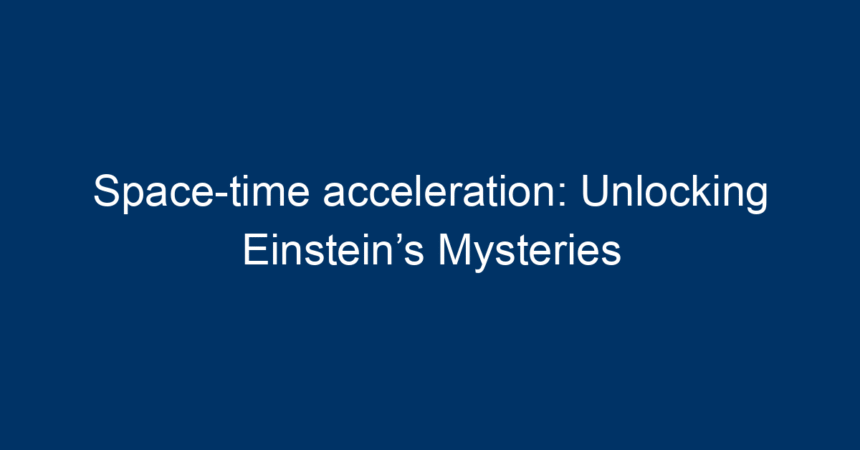Introduction
The universe is a vast and intricate tapestry woven with the threads of time and space. As we delve deeper into the cosmos, the concept of space-time acceleration emerges as a pivotal theme. This phenomenon not only challenges our understanding of physics but also brings us closer to unraveling some of Albert Einstein’s most enduring mysteries. In this article, we’ll navigate through the dimensions of space and time, explore the implications of acceleration in these realms, and illuminate how this knowledge can shape our future.
Understanding Space-Time: A Brief Overview
What is Space-Time?
Space-time is a four-dimensional continuum that merges the three dimensions of space with the dimension of time. Introduced by Einstein in his theory of relativity, this concept signifies that time and space are interconnected, forming a single fabric of reality.
The Prelude to Acceleration
Before we can fully grasp space-time acceleration, it’s essential to understand how objects behave within this continuum. According to the theory of relativity, massive objects like stars and planets warp the fabric of space-time around them. This warping affects the motion of other objects, leading to phenomena such as gravity.
The Concept of Acceleration in Space-Time
What is Space-Time Acceleration?
Space-time acceleration refers to the change in an object’s velocity as it moves through the fabric of space-time. This concept enriches our understanding of motion, revealing that acceleration can affect time perception and spatial dynamics.
The Role of Gravity
Gravity plays a pivotal role in space-time acceleration. It not only attracts bodies toward each other but also influences the flow of time. In regions of strong gravitational fields, time moves slower than in areas of weak gravity, a phenomenon verified by experiments involving atomic clocks.
Einstein’s Theory of Relativity
Special Relativity: The Foundation of Space-Time
In 1905, Einstein introduced the theory of special relativity, which laid the groundwork for our understanding of space-time. One of the main tenets of this theory is that the laws of physics are consistent for all observers, irrespective of their relative motion.
- Time Dilation: As speeds approach the speed of light, time for the moving object slows down relative to a stationary observer. This leads to fascinating implications regarding the nature of time, particularly in the context of space-time acceleration.
General Relativity: Elevating the Concept
Einstein’s general relativity, published in 1915, expanded upon special relativity by introducing gravity as a curvature of space-time.
- Gravitational Waves: A groundbreaking prediction of this theory, gravitational waves, were first detected in 2015. These ripples in space-time further underscore the dynamic nature of the universe and the acceleration resulting from massive celestial events.
The Mysteries of Space-Time Acceleration
Black Holes: Portals of Acceleration
One of the most tantalizing aspects of space-time acceleration occurs near black holes. These enigmatic regions of space exhibit extreme gravitational pulls that significantly warp the surrounding space-time fabric.
- Event Horizon: Once an object crosses this boundary, not even light can escape, making black holes an extreme example of space-time acceleration. Here, time behaves differently, sparking speculative theories about time travel and parallel universes.
Dark Matter and Dark Energy
Despite our advances, much of the universe remains a mystery, particularly dark matter and dark energy.
- Accelerated Expansion: Observations indicate that the universe is expanding at an accelerating rate due to dark energy, which comprises about 68% of the total energy density of the cosmos. This phenomenon prompts scientists to reassess theoretical frameworks surrounding space-time and gravity.
The Science of Acceleration: Experimental Evidence
Testing Einstein’s Theories
Many experiments have validated Einstein’s theories regarding space-time acceleration. The most notable include:
-
The Hafele–Keating Experiment: In the 1970s, atomic clocks were flown around the world on commercial flights. Upon comparison with clocks at the same altitude, results confirmed the predictions of time dilation, supporting the idea that acceleration could alter the pace of time.
- LIGO and Gravitational Waves: The detection of gravitational waves has provided empirical evidence of the fluctuations in space-time caused by massive cosmic events, further affirming Einstein’s profound impact on our understanding of the universe.
Practical Applications of Space-Time Acceleration
GPS Technology
Understanding space-time acceleration is not merely academic; it has practical implications in technology, especially with satellites.
- Global Positioning System (GPS): GPS relies on accurate timing. Satellite clocks, which experience both velocity and gravitational effects, must be corrected for space-time acceleration to ensure precise positioning on Earth.
Future Technologies
As we unlock the mysteries surrounding space-time acceleration, the possibilities for future technology appear limitless.
- Quantum Computing: As quantum computers advance, we may navigate and manipulate space-time at unprecedented scales, potentially leading to innovations in travel, communication, and beyond.
Conclusion: Insights for the Future
The exploration of space-time acceleration is not just about unlocking the secrets of the universe; it offers a new lens through which we can view our reality. By understanding how acceleration shapes galaxies, time, and technology, we can better prepare for a future that is as boundless as the cosmos itself.
Actionable Insights
- Stay Informed: Follow developments in astronomy and physics to grasp how space-time acceleration affects our understanding of the universe.
- Engage with Science: Participate in community lectures or online courses focusing on astrophysics to deepen your knowledge.
- Embrace Innovation: Consider career paths in science and technology that leverage concepts from space-time acceleration to contribute to tomorrow’s breakthroughs.
By engaging with these ideas, you can contribute to a burgeoning field that holds the key to understanding the universe’s most profound mysteries. Explore, learn, and remain curious—the universe awaits!




